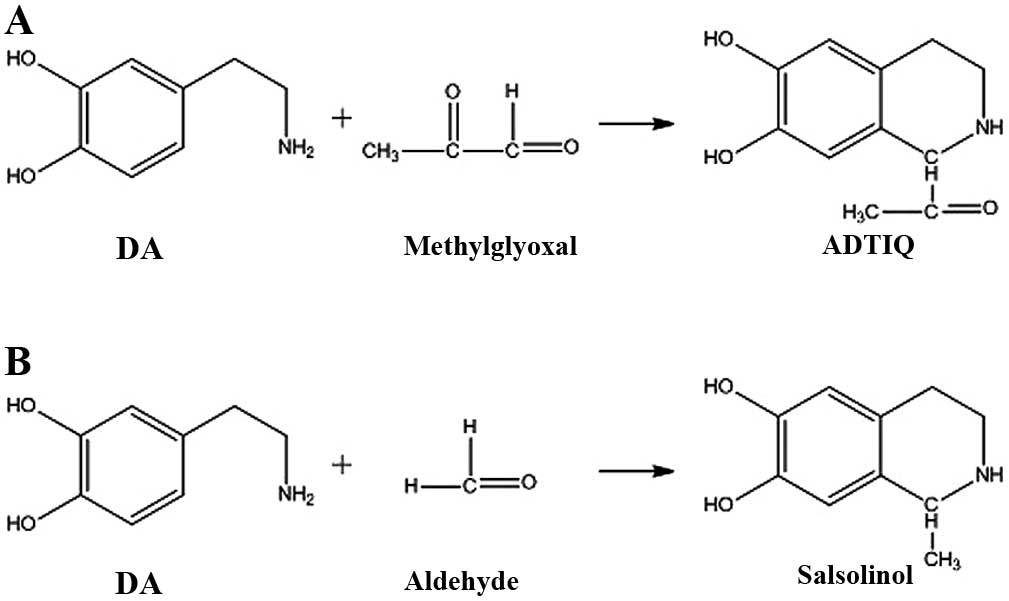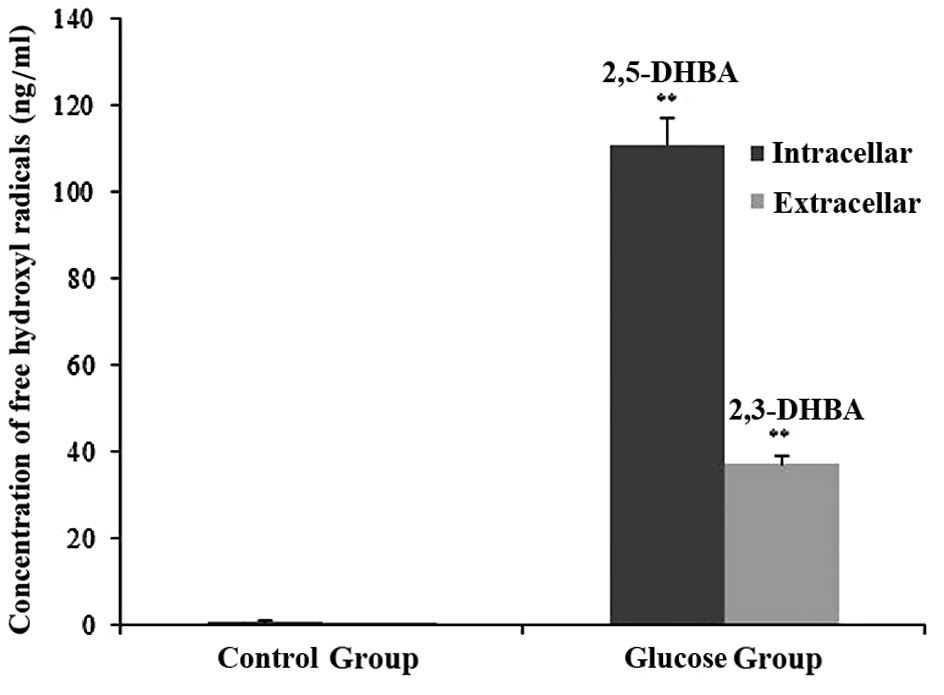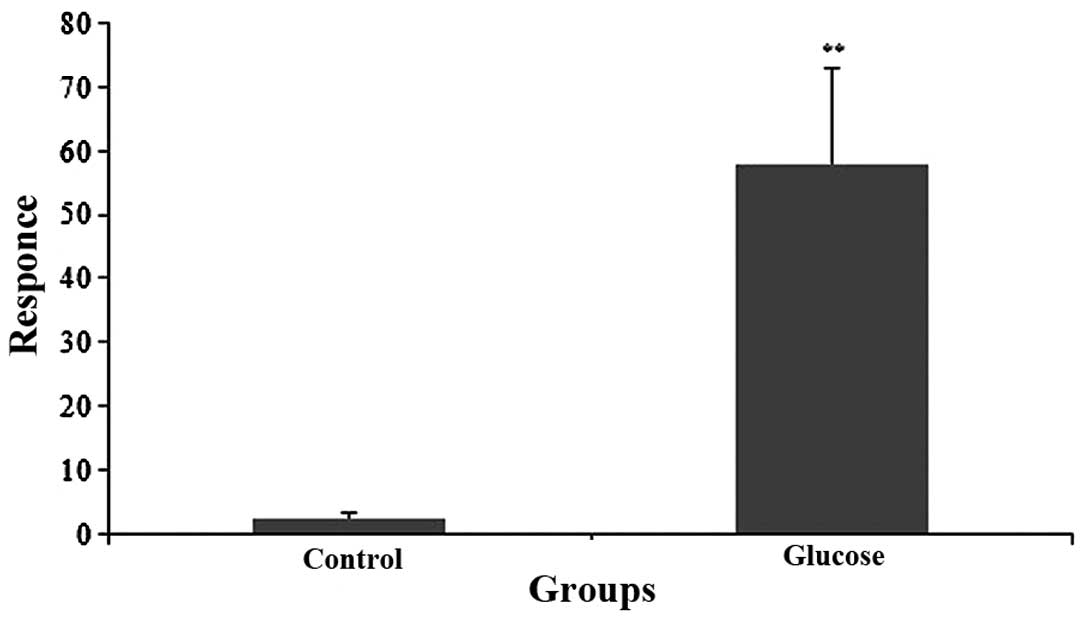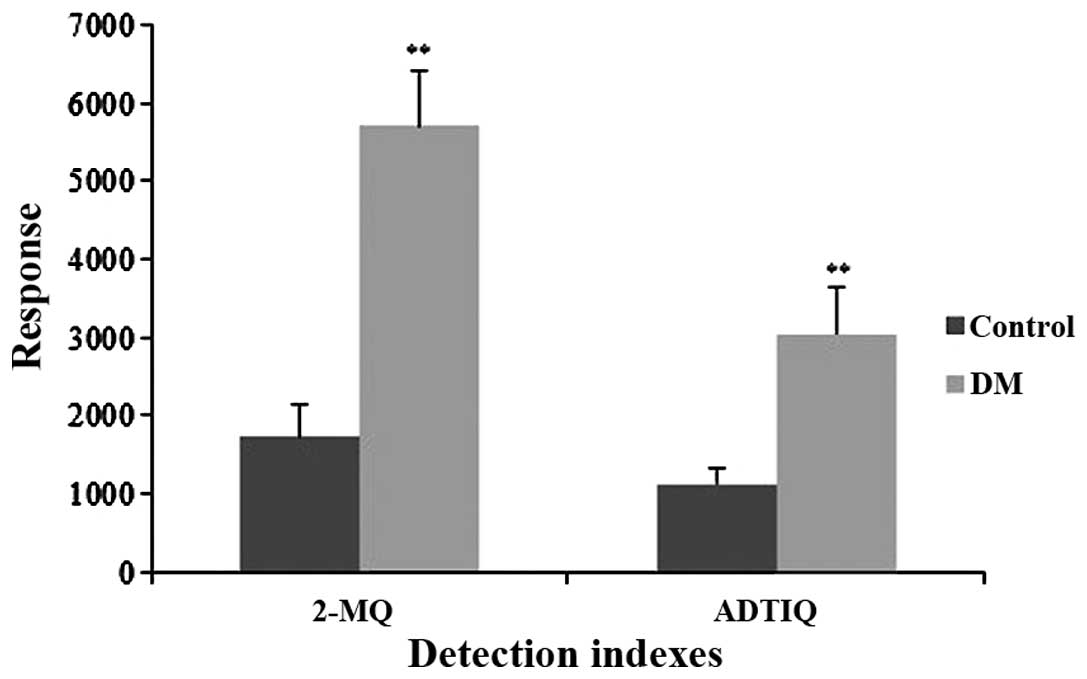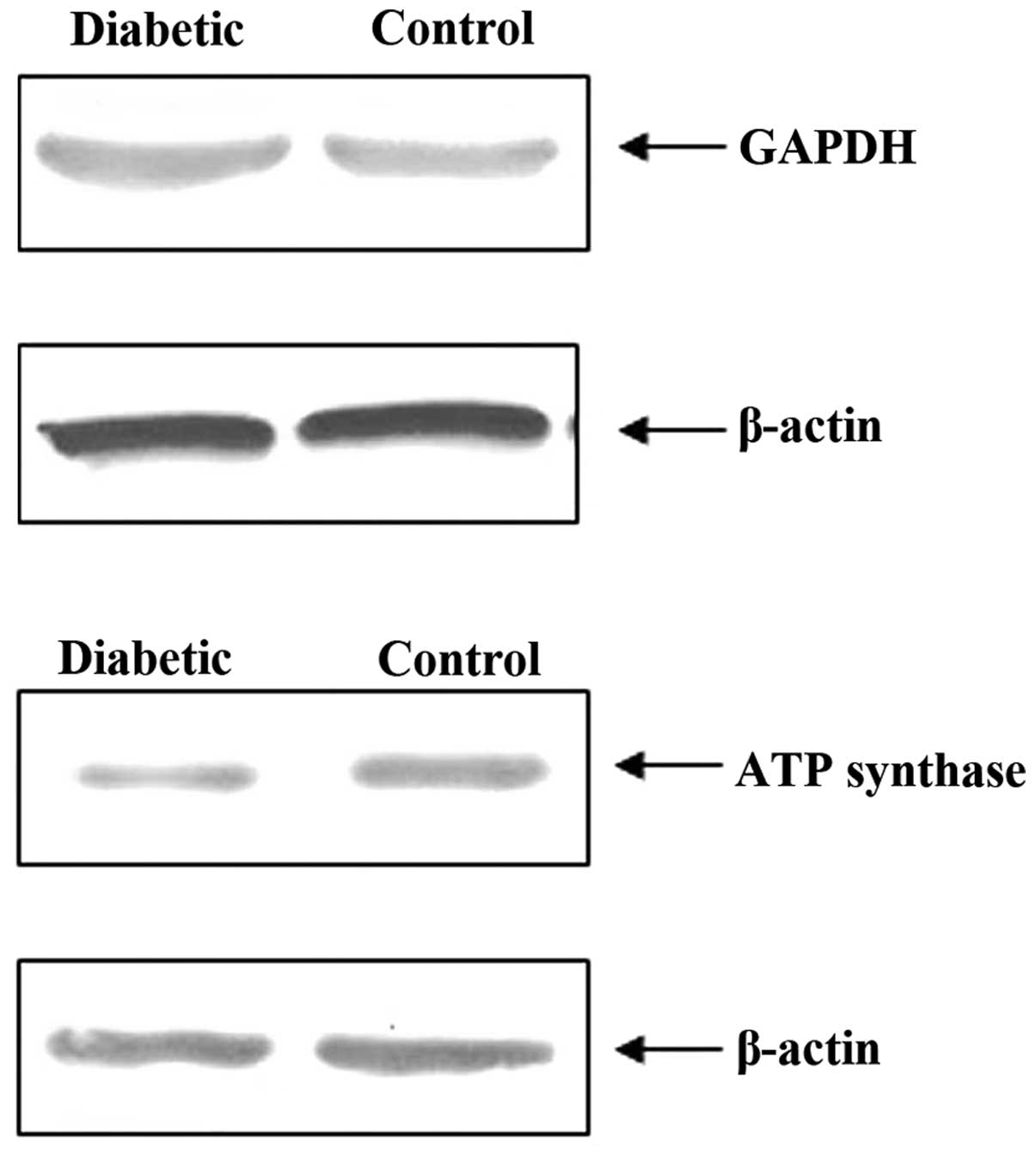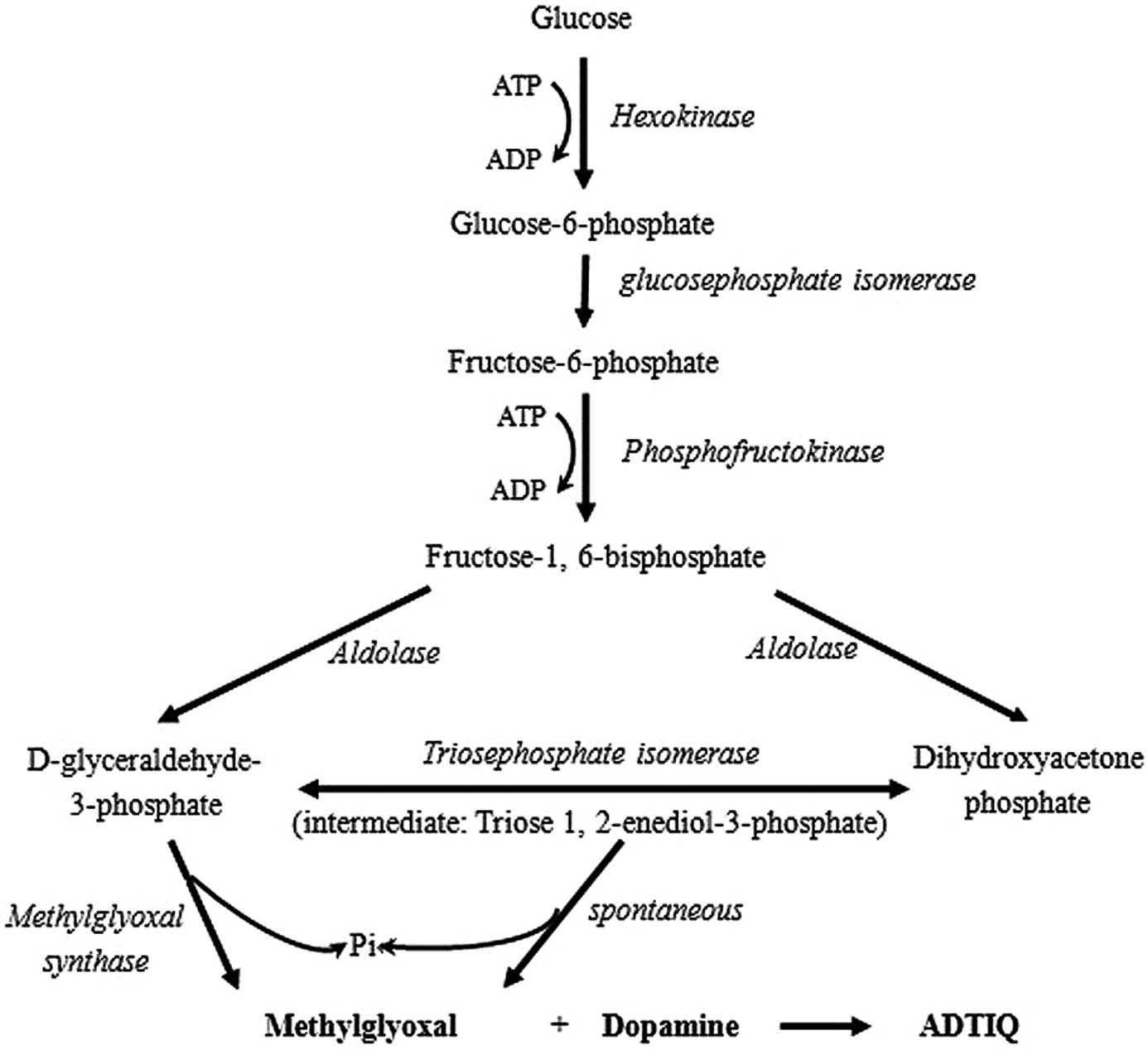Formation of a salsolinol-like compound, the neurotoxin, 1-acetyl-6,7-dihydroxy-1,2,3,4-tetrahydroisoquinoline, in a cellular model of hyperglycemia and a rat model of diabetes
- Authors:
- Published online on: December 24, 2013 https://doi.org/10.3892/ijmm.2013.1604
- Pages: 736-742
Abstract
Introduction
Diabetes mellitus (DM), as a state of chronic hyperglycemia, and Parkinson’s disease (PD) are diseases which consist a global health threat. In recent years, there have been increasing data indicating that hyperglycemia is associated with an increased risk of developing PD (1,2). However, the mechanisms underlying the association between hyperglycemia and PD have not yet been elucidated.
Deng and Rajput (6) were the first to report, in 2001, that 1-acetyl-6,7-dihydroxy-1,2,3,4-tetrahydroisoquinoline (ADTIQ), a salsolinol-like compound, is found at highly concentrated levels in the brains of patients who suffer from PD (3). When the brains of deceased patients with PD were compared to those of normal subjects, it was found that patients with PD presented elevated levels of ADTIQ in all the examined brain areas. This finding indicated that elevated ADTIQ expression levels may be one of the mechanisms involved in the increased risk patients with diabetes have of developing PD (4).
ADTIQ is an endogenous product acquired by a reaction between methylglyoxal (MG) and dopamine (DA). The reactive α-keto-aldehyde MG is the most important carbonyl, formed endogenously as a byproduct of the glycolytic pathway and formed either by the degradation of triosephosphates, or non-enzymatically by sugar fragmentation reactions (5). MG is gradually accumulated under hyperglycemic conditions, which may induce oxidative stress (6).
The neurotoxin, 1-methyl-4-phenyl-1,2,3,6-tetrahydropyridine (MPTP), is known to deplete striatal DA and to cause neuronal degeneration of the nigrostriatal pathway when administered to humans. The reason behind this, is that MPTP may induce oxidative stress and mitochondrial dysfunction, which can lead to PD (7). Catechol isoquinolines (CIQs) are considered to be naturally occurring MPTP-like neurotoxins. Salsolinol is demonstrated to be formed from DA and acetaldehyde by an (R)-salsolinol synthase-mediated condensation, N-methylated into (R)-N-methylsalsolinol by a neutral (R)-salsolinol N-methyltransferase, and then oxidized into an ion of 6,7-dihydroxy-1,2-dimethyl-isoqiolinium, an analogue of 1-methyl-4-phenylpyridinium (MPP+). The toxicity of N-methylsalsolinol and its oxidation product for dopaminergic neurons has previously been examined in vivo and in vitro (8,9).
The chemical structure of ADTIQ is very similar to that of salsolinol (Fig. 1). Therefore, in the current study, we hypothesize that ADTIQ may be another endogenous neurotoxin with a possibly negative effect on the nervous system, which may cause damage to the peripheral, automatic and central nervous systems, and may ultimately lead to PD.
In the present study, ADTIQ levels and those of its precursor, MG, were examined in a cell model of hyperglycemia and a rat model of diabetes. Proteomics was used to analyze the proteins involved, also analyzing their role in glucose metabolism.
Materials and methods
Cell line
The parental SH-SY5Y human neuroblastoma cell line was provided by Professor Wei-Hong Song (University of British Columbia).
Animals
The study complied with the ‘Guide for the Care and use of Laboratory Animals’ published by the US National Institutes of Health (NIH publication no. 85-23, revised in 1985) and all animal experiments were approved by the Institutional Animal Research Advisory Committee of the Beijing Institute of Technology. Wistar rats (male, 180–200 g body weight, 6–8 weeks old) and their granular food were provided by the Institute of Laboratory Animal Science, Chinese Academy of Medical Sciences (Beijing, China). The animals were maintained under a 12-h light/dark cycle at approximately 24±1ºC and were allowed free access to food and water.
Cell culture and establishment of the rat model of diabetes
The SH-SY5Y cells were grown under standard conditions in Dulbecco’s modified Eagle’s medium (DMEM) supplemented with 2 mM L-glutamine and 10% fetal calf serum at 37ºC (5% CO2).
A total of 40 Wistar rats were randomly divided into 2 groups, a control group and a diabetes model group (10 rats in the control group and 30 rats in the model group). Baseline blood glucose levels of all animals were measured after 12 h of fasting. Diabetes was induced by a single intraperitoneal injection of prepared streptozotocin (60 mg/kg body weight; Sigma, St. Louis, MO, USA) dissolved in sterile saline (0.85% NaCl). The control rats received an equal volume of the vehicle (normal saline). Non-fasting blood glucose levels were quantified a week later with the use of a commercially available glucometer. Streptozotocin-injected rats whose initial blood glucose levels were <300 mg/dl were considered as non-diabetic. Non-fasting blood glucose levels were monitored every 7th day during the course of the study and were examined again right before all the rats were anesthetized. The model group was fed for 18 weeks in order to imitate chronic hyperglycemia induced by long-term injury to the nervous system.
Measurement of free hydroxyl radicals in SH-SY5Y cells by high-performance liquid chromatography (HPLC)-electrochemical detector (ECD) assay
The SH-SY5Y cells were exposed to 60 mM glucose (10). After 48 h, the cells were harvested and 200 μl 10 mM ortho-oxybenzoic were added to the cells. The cells were lysed by sonication (50 cycles of 10 sec), centrifuged at 16,000 × g (4ºC, 10 min) following incubation with 0.4 M PCA (1:2/v:v) for 30 min, and passed through a 0.22-μm filter membrane prior to analysis. All these samples were analyzed by HPLC-ECD using a CoulArray Electrochemical Detector (Model 5600A; ESA, USA) under the following conditions: i) the organic phase consisted of 10% methanol diluted in water (solvent A); ii) the balanced solution contained 35 mM citric acid, 45 mM sodium acetate, 0.13 mM Na2EDTA, 0.2 mM SHS water-solution, pH 4.0 (solvent B); while iii) for the stationary phase, Alltima C18 (4.6×150 mm, 5 μm) analytical column was used. The column had a flow rate of 1 ml/min, it reached a temperature of 30ºC, while its electric potential was: −50, 50, 300, 450, 650, 780, 900 mV. The volume of the sample used was 40 μl.
Detection of MG and ADTIQ in hyperglycemic cells and rats with diabetes by liquid chromatography (LC)-mass spectrometry (MS)
LC-MS for the detection of MG and ADTIQ was carried out as previously described (11,12). The prepared cells and brain tissues were lysed by sonication (50 cycles of 10 sec) and centrifuged at 16,000 × g (4ºC, 10 min) following incubation with 0.4 M PCA (1:2/v:v) for 30 min. The supernatant was passed through a 0.22-μm filter membrane. O-phenylenediamine (2 mM) was added to the samples followed by incubation for 1 h at 37ºC. As MG cannot be retained on C18 columns, an indirect derivatization method was used to measure MG levels in the rat brains. MG reacted with o-phenylenediamine and the product, 2-methylquinoxaline (2-MQ), was detected as a measure of MG content. Tissue samples were separated into 2 groups, one for derivatization and another for no derivatization.
LC was performed with the discovery F5-SH column (4.6×250 mm, 5 μm). The mobile phase consisted of 32% methanol and 68% formic acid (pH 3.49), while the flow rate was 0.7 ml/min and the UV detection wave length 315 nm. The volume of the sample analyzed was 50 μl. Mass spectrum analysis was performed under the following conditions: mode electrospray ionization (ESI), positive ion mode; MS scanning; nebulizer pressure, 28 psi; drying gas flow rate, 8 l/min; scanning range, 135–225 m/z; and extracted ion chromatography (EIC), 145 (2-MQ) and 208 (ADTIQ).
Protein extraction and trypsin digestion
The control and model rat brain specimens were prepared and lysed by sonication (50 cycles of 10 sec) in 300 μl lysis buffer [8 M urea, 4% 3-((3-cholamidopropyl)dimethylammonio)-1-propanesulfonic acid (CHAPS), 10 mM dithiothreitol (DTT) and 0.09 g solid urea]. The homogenates were left at room temperature for 1 h after having been centrifuged at 20,000 × g for 60 min at 4ºC, and the supernatants were then collected as protein extracts. Protein concentration was determined by the Lowry method after dialysis. Proteins (500 μg) were freeze-dried at −56ºC under a vacuum, as previously described (13,14).
Desiccated proteins were dissolved in 200 μl buffer solution (8 M urea, 10 mM DTT and 50 mM NH4HCO3) and incubated at 37ºC for 4 h. Subsequently, 5 μl of iodoacetamide (1 M) were added in order for the alkylation reaction to occur in the dark for 1 h. The urea concentration was diluted in 500 μl NH4HCO3 (50 mM). Porcine trypsin (Promega, Madison, WI, USA) was added in a final enzyme to protein ratio of 1:20. Digestion was conducted at 37ºC for 18 h.
Peptide detection and quantification by LC-ESI-time-of-flight (TOF) MS
The quantification of the peptide mixtures in limited amounts of rat brain tissues was carried out by LC-ESI-TOF-MS (Agilent 6210 Time-of-Flight LC/MS System; Agilent Technologies, Inc., Santa Clara, CA, USA). Samples were separated by a C18 column (4.6×250 mm, 5 μm) in acetonitrile-0.1% formic acid (5:95) (mobile phase) with a flow rate of 0.8 μl/min for online enrichment. They were then analyzed by a Zorbax C18 column (0.5×150 mm, 5 μm). The peptides were separated and analyzed completely within 70 min. The ESI positive scanning range was 300–1,800 m/z.
Analysis of peptides by LC-MS/MS
The peptide mixtures were separated by chromatography and analyzed by ion trap mass spectrometry (Agilent 1100 series LC/MSD mass spectrometer; Agilent Technologies, Inc.) with the reversed-phase (RP) C18 column (4.6×250 mm, 5 μm), at a flow rate of a 0.8 ml/min. Samples of proteolytic digests (80 μl) were injected into the column and run with a linear gradient of 95% solvent A (0.1% formic acid) to 100% solvent B (acetonitrile) for a time period of 70 min and post run for another 10 min (14).
Bioinformatics analysis
MassHunter and MassProfiler, analysis software provided by Agilent Technologies, Inc. were used in order to analyze the TOF data. Significantly differentially expressed peptides were selected from the mass data. The same samples were analyzed by LC-TOF before they were validated by LC-MS/MS. The m/z value of significantly differentially expressed peptides was preferentially selected for LC-MS/MS analysis.
Trypsin cleaves proteins at the C terminus of lysine and arginine residues, thereby generating a peptide mass fingerprint (PMF) that can be used to search databases. The MS/MS data were searched using the MASCOT tool (http://www.matrixscience.com; Matrix Science, London, UK). The threshold parameter values for mass accuracy were 150 ppm and one miscleavage was allowed. The search was performed against rat protein sequences. PMFs from our samples were compared to corresponding fingerprints from NCBInr (http://ncbi.nih.gov/National Center for Biotechnical Information, Bethesda, MD, USA), MSDB (csc-fserve.hh.med.ic.ac.uk/msdb.html/Proteonomics Department, Hammersmith Campus, Imperial College, London, UK) and EnsemblC (http://www.ensembl.org/Sanger Centre, Hinxton, UK) databases in order to find matches with the virtual tryptic protein masses. Gene Ontology entries were retrieved based on the IPI data files from Swiss-Prot. Gene Ontology terms were mapped to Ontoglyph terms (http://61.50.138.118/GOfact/) to provide a coarse-grained classification of gene function (15).
Detection of protein content by western blot analysis
Brain homogenate expression levels of glyceraldehyde-3-phosphate dehydrogenase (GAPDH) and adenosine triphosphate (ATP) synthase were determined by western blot analysis. First, the proteins were separated by SDS-PAGE, then electrotransferred (electrodes were attached and the power supply was set to 100 V at constant voltage for 1 h at 4ºC). Finally, immunodetection was carried out as follows: the membranes were stained, blocked and washed, and then subjected to first antibody and second antibody and detection for the target protein.
Statistical analysis
SPSS 13.0 software (SPSS, Chicago, IL, USA) was used for statistical analysis. Values are expressed as the means ± standard deviation (SD). Data were analyzed using one-way ANOVA, followed by a Student’s two-tailed paired t-test for comparisons between 2 groups. A P-value <0.05 was considered to indicate a statistically significant difference.
Results
Measurement of free hydroxyl radicals in hyperglycemic SH-SY5Y cells
Salicylic acid hydroxylation is a specific scavenger for free hydroxyl radicals. Thus, the hydroxylation products, 2,3-dihydroxybenzoic acid (2,3-DHBA) and 2,5-dihydroxybenzoic acid (2,5-DHBA), were measured in order to indirectly evaluate the degree of oxidative stress (16). Free hydroxyl radicals in the SH-SY5Y cells treated with or without glucose were measured by HPLC-ECD assay. No 2,3-DHBA or 2,5-DHBA expression was detected in the control cells. However, there was a large quantity of free hydroxyl radicals in the hyperglycemic cells. Compared with the cells in the control group, an elevated level of glucose markedly promoted free hydroxyl radical formation in the hyperglycemic cells (p<0.01) (Fig. 2).
Measurement of ADTIQ levels in the cell model of hyperglycemia
Only minimal amounts of ADTIQ were detected in the control group, contrary to the large amount that was detected in the cells treated with a final concentration of 60 mM glucose for 2 h. Compared with the control group, we observed a significant increase in the expression levels of ADTIQ in the neuronal SH-SY5Y cells cultured under hyperglycemic conditions following a 2-h incubation period (p<0.01) (Fig. 3).
Measurement of MG and ADTIQ levels in the brains of rats with diabetes
The abundance of MG can be indirectly determined by measuring the levels of 2-MQ (17). LC/MS analysis was conducted to determine whether ADTIQ accumulated in the brains of rats with diabetes. The results indicated that the brains of rats with diabetes rat had significantly higher levels of ADTIQ (p<0.01) compared with the control group (Fig. 4).
Measurement of relative protein levels in rat brains
A proteomics approach was used to search for differentially expressed proteins in the brains of rats with diabetes (Materials and methods). The results of this proteomics and bioinformatics analysis revealed that, in comparison to the control group, the expression levels of 7 key enzymes from the glycolytic pathway were significantly increased in the brains of rats with diabetes, while the levels of ATP synthase, an enzyme from the oxidative phosphorylation pathway, and of those superoxide dismutase (SOD) were significantly decreased. Compared with the control group, the diabetes group had a higher rate of glycolysis and a lower rate of oxidative phosphorylation (Table I).
Table IExpression profiles of nine proteins in the brains of the control rats and rats with diabetes. |
Two proteins, GAPDH and ATP synthase, were selected to be semi-quantified by western blot analysis in order to verify the reliability of the proteomics results. It was shown that, compared with the control group, the GAPDH content in the rats with diabetes was increased while the ATP synthase content was decreased. These results were consistent with the those from proteomics analysis. Thus, the comparative proteomics analysis proved to be a feasible and reliable approach for studying relative protein levels (Fig. 5).
Discussion
The pathological process of PD is complex, involving a number of different factors, such as mitochondrial dysfunction, abnormal protein aggregation, familial inheritance and excitotoxicity (18). A previous study demonstrated that CIQs, such as salsolinol and NM-salsolinol are promising endogenous neurotoxins that may lead to the development of PD (19). Thus, a ‘vicious’ cycle may be induced by CIQs. ADTIQ is structurally similar to salsolinol, and has been suggested to be a neurotoxin (20,21).
Glycolysis is a crucial process in DM and the most extensively investigated metabolic pathway (22). MG is an important byproduct in this pathway and its production is increased due to hyperglycemia. The formation of dihydroxyacetone phosphate and D-glyceraldehyde-3-phosphate by fructose-1, 6-bisphosphate is catalyzed by aldolase. Triosephosphate isomerase catalyzes the aldoketose isomerization of these triosephosphates and eventually only D-glyceraldehyde-3-phosphate follows the glycolytic pathway, by being converted into 1,3-bisphosphoglycerate in a reaction catalyzed by D-glyceraldehyde-3-phosphate dehydrogenase (23). However, triose phosphates are unstable molecules and L-elimination reactions of the phosphoryl group from the common 1,2-enediolate of both trioses may occur, leading to MG formation (24,25). This is a non-enzymatic, parametabolic reaction and therefore MG occurrence is an unavoidable consequence of glycolytic metabolism (26). MG can also be formed from the leakage of the 1,2-enediolate intermediate in the active center of triosephosphate isomerase in a paracatalytic reaction (27). Consequently, ADTIQ is produced when DA reacts with MG (Fig. 6).
As previously demonstrated, reactive oxygen species (ROS) induced by high glucose levels are involved in vivo in both death receptor- and mitochondrial-dependent apoptosis of the nervous system (28). Antioxidants may be a therapeutic option for preventing cardiovascular damage in patients with DM. ROS has been shown to be involved in collagen-induced platelet activation and aggregation (29).
In the SH-SY5Y cell model of hyperglycemia, a large amount of free radicals was generated during the course of treatment with high glucose, consistent with the observation that ROS generation and elimination systems were imbalanced under hyperglycemic conditions. Intracellular ROS and hydroxyl radical accumulation induced lipid peroxidation (LPO) (30); thus, lipid molecules were consumed uninterruptedly, decreasing the amount of unsaturated fatty acid and affecting the fluidity of biological membranes (31). MG and other aldehydes react with proteins and enzymes, which cause them to lose their biological activity and lead to an abnormal metabolism. Specifically, MG reacts with DA to form ADTIQ, which confirms the hypothesis that CIQs induce a ‘vicious’ cycle of oxidative stress.
In the present study, compared with the control group, the ADTIQ levels in the brains of rats with diabetes were found to be significantly elevated (p<0.01). We also demonstrated that the levels of 7 key enzymes from the glycolytic pathway were increased significantly in the brains of rats with diabetes. More precisely, the expression levels of fructose-bisphosphate aldolase and triosephosphate isomerase were higher, suggesting that hyperglycemia enhanced the concentration of dihydroxyacetone phosphate and D-glyceraldehyde-3-phosphate, thus leading to an increase in MG and ADTIQ levels. When ADTIQ accumulated and reached a critical level, it damaged neurons and induced oxidative stress and apoptosis. Our results also indicated that SOD and ATP synthase protein levels were significantly reduced in the rats with diabetes. SOD is a potent antioxidant enzyme which exerts its effects by scavenging ROS. There are data suggesting that elevated glucose levels serve as a causal link between the mitochondrial hyperglycemia-induced overproduction of superoxide and each of the three major pathways responsible for hyperglycemic vascular damage caused to endothelial cells (32,33). It has previously been demonstrated that the C-peptide has a preventative effect on neuronal hippocampal apoptosis in type 1 diabetes, although it does not have any effect on oxidative stress (34,35). These results indicate that hyperglycemic conditions may reduce the activity of SOD; however, the mechanisms involved remain unclear. The decreased levels of ATP synthase suggest that hyperglycemic conditions may induce mitochondrial dysfunction and thus lead to the apoptosis of neuronal cells. However, it is evident that multiple factors are involved in the progression from diabetes to PD.
In conclusion, the present study demonstrates that ADTIQ may be a type of endogenous neurotoxin and is found in the brains of rats with diabetes. We also provide evidence in support of the existence of a ‘vicious’ cycle of oxidative stress. The accumulation of ADTIQ in diabetes be an important factor in the connection between diabetes and PD.
Acknowledgements
The authors wish to acknowledge the financial support provided by the Ministry of Science and Technology of the People’s Republic of China (grant nos. 2012YQ040140, 2009BAK59B01, 02 and 03) and the National Natural Science Foundation of China (grant no. 81202996).
Abbreviations:
|
ADTIQ |
1-acetyl-6,7-dihydroxy-1,2,3,4-tetrahydroisoquinoline |
|
ATP |
adenosine triphosphate |
|
CHAPS |
3-[(3-cholamido- propyl) dimethylammonio]-1-propanesulfonic acid |
|
CIQs |
catechol isoquinolines |
|
DA |
dopamine |
|
2,3-DHBA |
2,3-dihydroxybenzoic acid |
|
2,5-DHBA |
2,5-dihydroxybenzoic acid |
|
DM |
diabetes mellitus |
|
DMEM |
Dulbecco’s modified Eagle’s medium |
|
DTT |
dithiothreitol |
|
ECD |
electrochemical detector |
|
GAPDH |
glyceraldehyde-3-phosphate dehydrogenase |
|
LPO |
lipid peroxidation |
|
MG |
methylglyoxal |
|
MPP+ |
1-methyl-4-phenylpyridinium |
|
MPTP |
1-methyl-4-phenyl-1,2,3,6-tetra- hydropyridine |
|
RP |
reversed-phase |
|
2-MQ |
2-methylquinoxaline |
|
MTT |
3-(4,5-dimethyl-2-thiazolyl)-2,5-diphenyl-2H-tetrazolium bromide |
|
PD |
Parkinson’s disease |
|
PMFs |
peptide mass fingerprints |
|
ROS |
reactive oxygen species |
|
SOD |
superoxide dismutase |
References
|
Xu Q, Park Y, Huang X, Hollenbeck A, Blair A, Schatzkin A and Chen H: Diabetes and Risk of Parkinson’s Disease. Diabetes Care. 34:910–915. 2011. | |
|
Schernhammer E, Hansen J, Rugbjerg K, Wermuth L and Ritz B: Diabetes and the risk of developing Parkinson’s disease in Denmark. Diabetes Care. 34:1102–1108. 2011. | |
|
Arvanitakis Z, Wilson RS, Schneider JA, Bienias JL, Evans DA and Bennett DA: Diabetes mellitus and progression of rigidity and gait disturbance in older persons. Neurology. 63:996–1001. 2004. View Article : Google Scholar : PubMed/NCBI | |
|
Deng YL, Zhang YQ, Li YJ, Xiao SY, Song DW, Qing H, Li Q and Rajput AH: Occurrence and distribution of salsolinol-like compound, 1-acetyl-6,7-dihydroxy-1,2,3,4-tetrahydroisoquinoline (ADTIQ) in parkinsonian brains. J Neural Transm. 119:435–441. 2012. View Article : Google Scholar : PubMed/NCBI | |
|
Ristow M: Neurodegenerative disorders associated with diabetes mellitus. J Mol Med (Berl). 82:510–529. 2004. View Article : Google Scholar : PubMed/NCBI | |
|
Deng YL and Rajput AM: 126th Annual Meeting, American Neurological Association: Abstracts: Plenary Session: Epilepsy. Ann Neurol. 50(Suppl 1): S19–S22. 2001. View Article : Google Scholar | |
|
Haik GM Jr, Lo TW and Thornalley PJ: Methylglyoxal concentration and glyoxalase activities in the human lens. Exp Eye Res. 59:497–500. 1994. View Article : Google Scholar : PubMed/NCBI | |
|
Zhu W, Wang D, Zheng J, An Y, Wang Q, Zhang W, Jin L, Gao H and Lin L: Effect of (R)-salsolinol and N-methyl-(R)-salsolinol on the balance impairment between dopamine and acetylcholine in rat brain: involvement in pathogenesis of Parkinson disease. Clin Chem. 54:705–712. 2008. View Article : Google Scholar : PubMed/NCBI | |
|
Zhang Y, Xiao S, Wang L, Wang H, Zhu Y, Li Y and Deng Y: Absolute quantification of semicarbazide-sensitive amine oxidase in human umbilical artery by single-reaction monitoring with electrospray tandem mass spectrometry. Anal Bioanal Chem. 397:709–715. 2010. View Article : Google Scholar | |
|
Wang R, Qing H, Liu XQ, Zheng XL and Deng YL: Iron contributes to the formation of catechol isoquinolines and oxidative toxicity induced by overdose dopamine in dopaminergic SH-SY5Y cells. Neurosci Bull. 24:125–132. 2008. View Article : Google Scholar : PubMed/NCBI | |
|
Song DW, Du HQ, Wang L, Hu GF and Deng YL: Analysis of catechol quinoline substance in corpus striatum and hippocampus from brains of diabetic rat models by HPLC-MS. Chemistry. 11:1049–1052. 2010. | |
|
Song DW, Hu GF, Zhou Y, Wang HB, Wang L, Zhu Y and Deng YL: Proteomic analysis of proteins related to Parkinson’s disease in the corpus striatum and hippocampus of diabetes rat model. Chemistry. 6:430–434. 2008. | |
|
Kuhla B, Loske C, Garcia De Arriba S, Schinzel R, Huber J and Münch G: Differential effects of ‘Advanced glycation endproducts’ and beta-amyloid peptide on glucose utilization and ATP levels in the neuronal cell line SH-SY5Y. J Neural Transm. 11:427–439. 2004. | |
|
Emdadul Haque M, Asanuma M, Higashi Y, Miyazaki I, Tanaka K and Ogawa N: Apoptosis-inducing neurotoxicity of dopamine and its metabolites via reactive quinone generation in neuroblastoma cells. Biochim Biophys Acta. 1619:39–52. 2003.PubMed/NCBI | |
|
Collins MO, Yu L, Coba MP, Husi H, Campuzano I, Blackstock WP, Choudhary JS and Grant SGN: Proteomic analysis of in vivo phosphorylated synaptic proteins. J Biol Chem. 280:5972–5982. 2005. View Article : Google Scholar : PubMed/NCBI | |
|
Song DW, Li Q, Luan YJ, Niu LY, Qing H and Deng YL: Comparative proteomic analysis of neural stem cells between differentiating and undifferentiating to dopaminergic neuron. Complex Medical Engineering (CME). In: IEEE/ICME International Conference, 1817–1823; 2007 | |
|
Diez L, Livertoux MH, Stark AA, Wellman-Rousseau M and Leroy P: High-performance liquid chromatographic assay of hydroxyl free radical using salicylic acid hydroxylation during in vitro experiments involving thiols. J Chromatogr B Biomed Sci Appl. 763:185–193. 2001. View Article : Google Scholar | |
|
Ferger B, Spratt C, Earl CD, Teismann P, Oertel WH and Kuschinsky K: Effects of nicotine on hydroxyl free radical formation in vitro and on MPTP-induced neurotoxicity in vivo. Naunyn Schmiedebergs Arch Pharmacol. 358:351–359. 1998. View Article : Google Scholar : PubMed/NCBI | |
|
Copeland RL Jr, Das JR, Kanaan YM, Taylor RE and Tizabi Y: Antiapoptotic effects of nicotine in its protection against salsolinol-induced cytotoxicity. Neurotox Res. 12:61–69. 2007. View Article : Google Scholar : PubMed/NCBI | |
|
Yi H, Maruyama W, Akao Y, Takahashi T, Iwasa K, Youdim MB and Naoi M: N-Propargylamine protects SH-SY5Y cells from apoptosis induced by an endogenous neurotoxin, N-methyl(R)salsolinol, through stabilization of mitochondrial membrane and induction of anti-apoptotic Bcl-2. J Neural Transm. 113:21–32. 2006. View Article : Google Scholar | |
|
Maruyama W, Akao Y, Youdim MB, Davis BA and Naoi M: Transfection-enforced Bcl-2 overexpression and an anti-Parkinson drug, rasagiline, prevent nuclear accumulation of glyceraldehyde-3-phosphate dehydrogenase induced by an endogenous dopaminergic neurotoxin, N-methyl(R)salsolinol. J Neurochem. 78:727–735. 2001. View Article : Google Scholar | |
|
Wanpen S, Kooncumchoo P, Shavali S, Govitrapong P and Ebadi M: Salsolinol, an endogenous neurotoxin, activates JNK and NF-kappaB signaling pathways in human neuroblastoma cells. Neurochem Res. 32:443–450. 2007. View Article : Google Scholar : PubMed/NCBI | |
|
Kheradpezhouh M, Shavali S and Ebadi M: Salsolinol causing parkinsonism activates endoplasmic reticulum-stress signaling pathways in human dopaminergic SK-N-SH cells. Neurosignals. 12:315–324. 2003. View Article : Google Scholar | |
|
Thornalley PJ, Jahan I and Ng R: Suppression of the accumulation of triosephosphates and increased formation of methylglyoxal in human red blood cells during hyperglycaemia by thiamine in vitro. J Biochem. 129:543–549. 2001. View Article : Google Scholar : PubMed/NCBI | |
|
Dmitriev LF and Dugin SF: Aldehydes and disturbance of carbohydrate metabolism: some consequences and possible approaches to its normalization. Arch Physiol Biochem. 113:87–95. 2007. View Article : Google Scholar : PubMed/NCBI | |
|
Sheu KF, Ho HT, Nolan LD, Markovitz P, Richard JP, Utter MF and Frey PA: Stereochemical course of thiophosphoryl group transfer catalyzed by mitochondrial phosphoenolpyruvate carboxykinase. Biochemistry. 23:1779–1783. 1984. View Article : Google Scholar | |
|
Richard JP: Mechanism for the formation of methylglyoxal from triosephosphates. Biochem Soc Trans. 21:549–553. 1993.PubMed/NCBI | |
|
Han YC, Randell E, Vasdev S, Gill V, Gadag V, Newhook LA, Grant M and Hagerty D: Plasma methylglyoxal and glyoxal are elevated and related to early membrane alteration in young, complication-free patients with Type 1 diabetes. Mol Cell Biochem. 305:123–131. 2007. View Article : Google Scholar : PubMed/NCBI | |
|
MacDonald MJ, Chaplen FWR, Triplett CK, Gong Q and Drought H: Stimulation of insulin release by glyceraldehyde may not be similar to glucose. Arch Biochem Biophys. 447:118–126. 2006. View Article : Google Scholar : PubMed/NCBI | |
|
Caccese D, Pratico D, Ghiselli A, Natoli S, Pignatelli P, Sanguigni V, Luliano L and Violi F: Superoxide anion and hydroxyl radical release by collagen-induced platelet aggregation - role of arachidonic acid metabolism. Thromb Haemost. 83:485–490. 2000.PubMed/NCBI | |
|
Shi HL and Liu KJ: Effects of glucose concentration on redox status in rat primary cortical neurons under hypoxia. Neurosci Lett. 410:57–61. 2006. View Article : Google Scholar : PubMed/NCBI | |
|
Adam W, Kurz A and Saha-Möller CR: Peroxidase-catalyzed oxidative damage of DNA and 2′-deoxyguanosine by model compounds of lipid hydroperoxides: involvement of peroxyl radicals. Chem Res Toxicol. 13:1199–1207. 2000. | |
|
Hong JH, Kim MJ, Park MR, Kwag OG, Lee IS, Byun BH, Lee SC, Lee KB and Rhee SJ: Effects of vitamin E on oxidative stress and membrane fluidity in brain of streptozotocin-induced diabetic rats. Clin Chim Acta. 340:107–115. 2004. View Article : Google Scholar : PubMed/NCBI | |
|
Sima AAF and Li ZG: The effect of C-peptide on cognitive dysfunction and hippocampal apoptosis in type 1 diabetic rats. Diabetes. 54:1497–1505. 2005. View Article : Google Scholar : PubMed/NCBI | |
|
Stevens MJ, Zhang W, Li F and Sima AA: C-peptide corrects endoneurial blood flow but not oxidative stress in type 1 BB/Wor rats. Am J Physiol Endocrinol Metab. 287:E497–E505. 2004. View Article : Google Scholar : PubMed/NCBI |



